Why Egypt is a Land of Timeless Treasures: Discover the Treasures of Egypt?
Egypt has long been recognized as more than just a destination—it is considered a living museum where the treasures of Egypt blend ancient wonders with modern marvels.. From monumental pyramids to sacred mountains, stories that have shaped human history can be discovered in every corner of this magnificent land. The lost treasures of Egypt continue to captivate travelers from across the globe, who are drawn to its mystical deserts, ancient temples, and historic cities. These visitors are attracted not only by what has been preserved for thousands of years but also by the magical essence of a civilization through which writing, art, architecture, and legendary tales were given to the world.
For those by whom it has been dreamed to walk where pharaohs once stood, or by whom it has been desired to gaze upon ancient treasures of Egypt that existed before most nations were established, Egypt should be positioned at the top of their travel list. In this comprehensive guide, 10 unique treasures of Egypt that cannot be found anywhere else will be explored—each treasure being accompanied by its own compelling story, distinctive charm, and compelling reason for modern-day visitation.
Core Themes: Treasures of Egypt
- Egypt is a living museum where the treasures of Egypt connect ancient wonders with modern marvels.
- The Great Pyramid of Giza remains one of the most iconic and enduring treasures of Egypt.
- Tutankhamun’s intact tomb revealed priceless artifacts, among the most celebrated treasures of Egypt.
- The Valley of the Kings and Luxor Temple showcase Egypt’s timeless spirituality and royal legacy.
- Monuments like Abu Simbel, the Step Pyramid of Djoser, and the Great Sphinx highlight Egypt’s architectural genius and stand proudly among the treasures of Egypt.
- From the Rosetta Stone to Ramses III’s legacy, the treasures of Egypt continue to inspire global fascination.
1. The Great Pyramid of Giza – Egypt’s Eternal Wonder
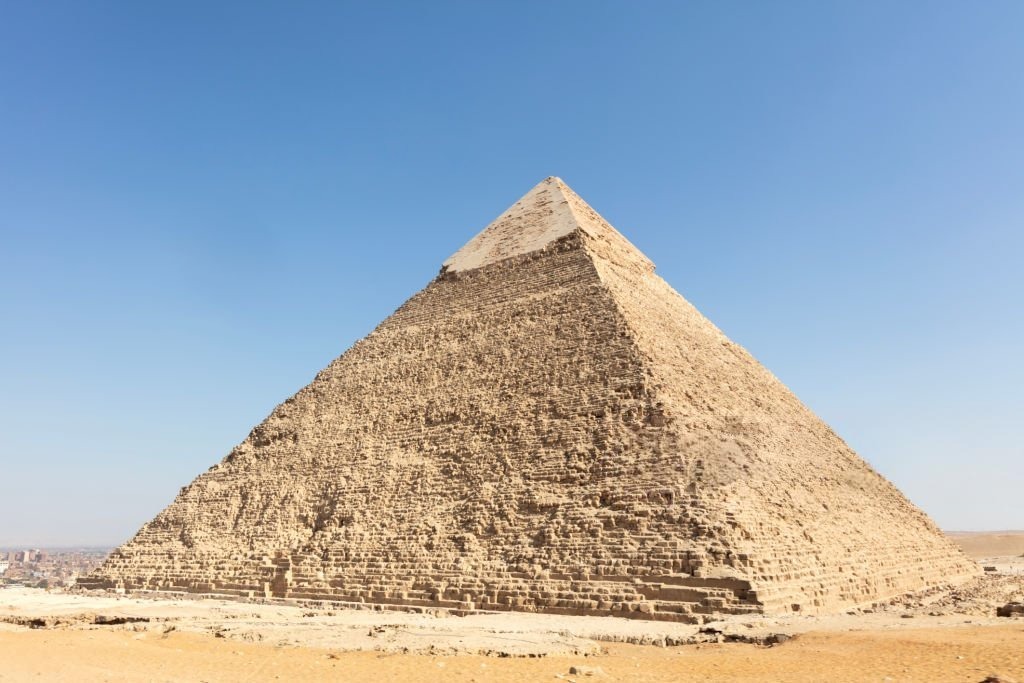
The History Behind the Great Pyramid
The Great Pyramid of Giza, also known as the Great Pyramid of Giza Egypt or Giza Great Pyramid, is the most iconic of all the Great Pyramids of Egypt and the crown jewel of the Pyramids of Giza. As well as it is one of the most enduring treasures of Egypt. Built as the eternal resting place of Pharaoh Khufu, it continues to fascinate historians and travelers alike.
For anyone wondering when was the Great Pyramid of Giza built, the answer lies in Egypt’s Old Kingdom, around 2,560 BC. In other words, when the Great Pyramid of Giza was built, it was not only the largest pyramid ever constructed but also the tallest man-made structure in the world for over 3,800 years.
Even today, questions such as how did they build the pyramids remain a mystery. The massive stones, each weighing several tons, were transported and placed with astonishing accuracy. Scholars still debate when were pyramids of Giza built, or more broadly, when were the pyramids made, but all agree that the Great Pyramid is the most extraordinary of the ancient treasures of Egypt.
Why Travelers Can’t Miss It
Many ask where is the Great Pyramid of Giza—it rises proudly on the Giza Plateau, just outside Cairo, Egypt. Its sheer size is breathtaking: if you’re curious about how tall is the Great Pyramid of Giza, it originally stood at 146 meters (481 feet). Even now, despite erosion, it towers at about 138 meters, leaving visitors in awe. Travelers who explore the Great Pyramid of Giza interior discover narrow passageways and the King’s Chamber, a journey back into the mystery of ancient Egypt. Experiencing it firsthand, you realize why it is celebrated among the greatest treasures of Egypt.
Best Tips for Visiting
- Arrive early in the morning to experience the site before the heat and large crowds.
- A licensed Egyptologist guide is highly recommended for insights into Khufu’s reign, the construction, and the secrets of the Great Pyramid of Giza interior.
- For the best views of the Great Pyramids of Egypt, especially the Great Pyramid itself, explore the plateau at sunset, when the golden light transforms the scene into something unforgettable.
2. Tutankhamun and His Tomb – The Boy King’s Legacy
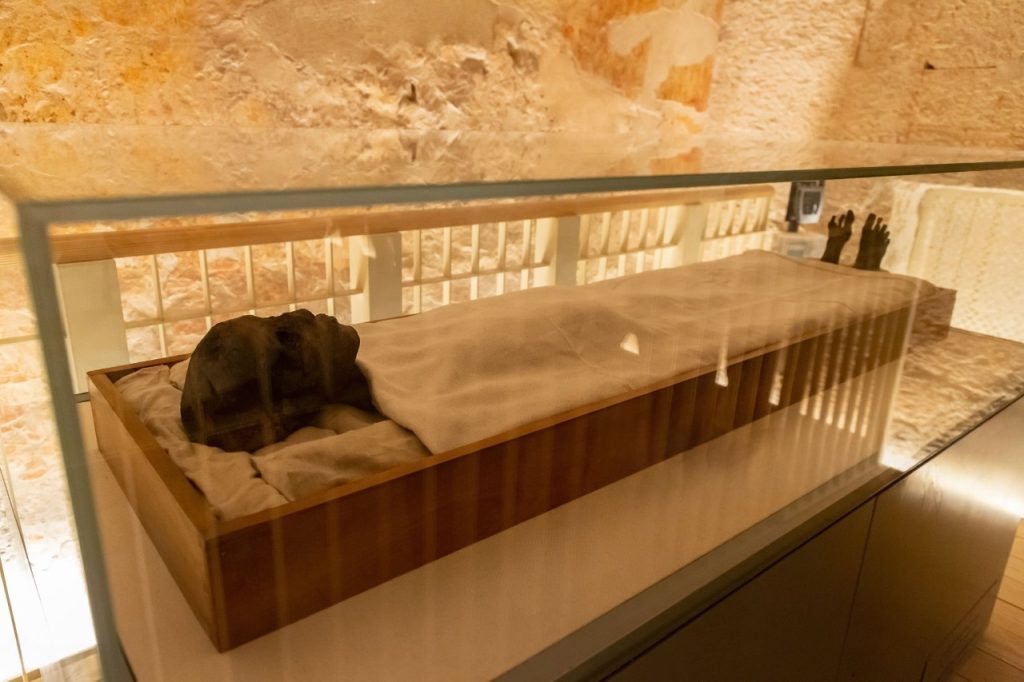
Tutankhamun’s Tomb and belongings: The Most valuable Treasures of Egypt
In 1922, one of the most significant treasures of ancient Egypt was unearthed when the tomb of King Tutankhamun was discovered by British archaeologist Howard Carter in the Valley of the Kings. Unlike numerous royal tombs that had been plundered through the centuries, this remarkable discovery was found to be nearly intact, by which priceless artifacts that had remained untouched for millennia were revealed to the modern world.
Treasures Inside the Tomb
Within the tomb’s chambers, an extraordinary collection of lost treasures of Egypt was discovered, including intricately crafted golden masks, precious jewelry, ornate chariots, and thousands of meticulously preserved objects by which a vivid portrayal of life and death in Ancient Egypt was painted. The iconic golden funerary mask continues to be recognized as one of the most celebrated artifacts in archaeological history, by which millions of visitors are attracted to Egypt annually.
Why Tutankhamun Fascinates Historians
Although the throne was occupied by Tutankhamun for only approximately a decade, his story is considered to be particularly compelling because his tomb is regarded as an unparalleled time capsule of ancient Egyptian culture. By his treasures, countless exhibitions worldwide are inspired, by which Egypt’s tourism industry is fueled and global fascination with ancient Egyptian civilization is perpetuated.
3. Valley of the Kings – Burial Ground of the Treasures of Egypt
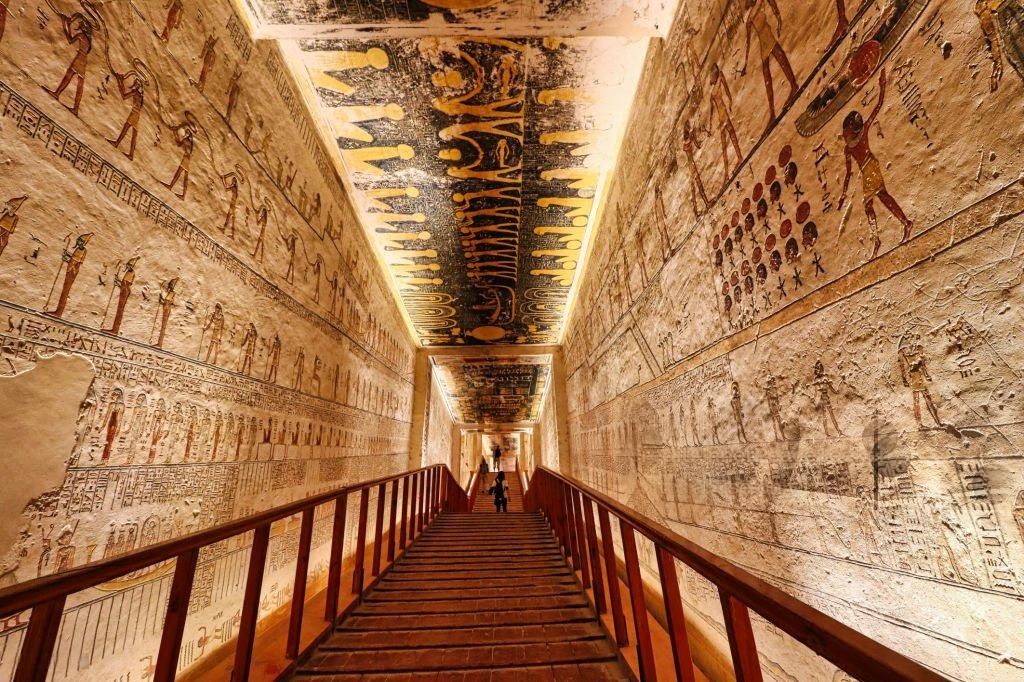
Royal Tombs and Hidden Secrets
In Luxor’s desert hills, the Valley of the Kings is located, where Egypt’s pharaohs prepared their journey to eternity. More than 60 tombs have been discovered in this valley, by which a treasure trove of hieroglyphics, paintings, and chambers is provided, through which ancient Egypt’s intricate beliefs about the afterlife are revealed.
Famous Tombs You Can Visit
- By the Tomb of Tutankhamun, the most famous mummies, tombs and treasures secrets of ancient Egypt are housed
- Within the Tomb of Ramses VI, spectacular astronomical ceiling decorations are featured
- The Tomb of Seti I is distinguished by its remarkably preserved colorful wall art
Travel Tips for Exploring
- Early ticket purchases are recommended; by some tombs, separate entry fees are required.
Travel Tips for Exploring
- By comfortable shoes, it is recommended that visitors be equipped, as extensive walking is necessitated by the exploration of these ancient treasures of Egypt.
- Early morning visits are strongly advised, by which cooler temperatures can be experienced and the harsh midday sun can be avoided during the treasures of Egypt tour.
4. Luxor Temple – A Living Monument of Ancient Thebes
The Luxor Temple, also called the Temple of Luxor, is one of the greatest treasures of Egypt. For those asking when was the Luxor Temple built or when was Luxor Temple built, it dates back to around 1400 BCE under Amenhotep III, with later additions by Ramses II. The story of Luxor Temple construction shows it was a royal temple for coronations, making what is the Luxor Temple unique compared to others.
Where is the Luxor Temple located? It stands in Luxor, Egypt, on the east bank of the Nile, right in the heart of Luxor Africa. Once linked to Karnak Temple Luxor by the Avenue of Sphinxes, the Karnak and Luxor Temples together formed the spiritual core of Thebes. Today, the Luxor Temple Luxor still features colossal statues, pylons, and the Abu al-Haggag Mosque within its grounds, proving it is a living monument among the timeless treasures of Egypt.
Travelers are especially drawn to Luxor Temple photos, whether taken by day or during the magical night illuminations. Visiting the Karnak and Luxor Temples remains one of the most unforgettable ways to experience the treasures of Egypt.
5.The Step Pyramid of Djoser – The First Monumental Pyramid
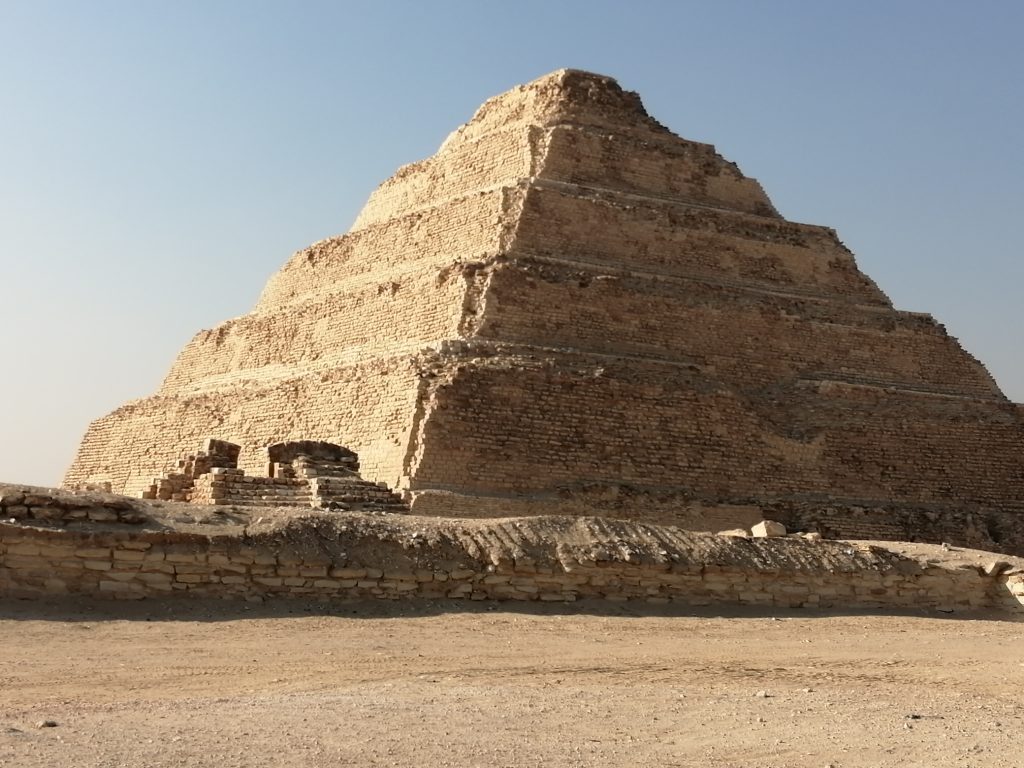
Historical and Architectural Significance
The Step Pyramid of Djoser, also known as the Egyptian Step Pyramid of Djoser, is one of the most important treasures of Egypt. Built in the 27th century BCE during the reign of King Djoser, it was designed by the legendary architect Imhotep. For those wondering what is the Step Pyramid or when was the first pyramid built, this structure holds the answer—it is the earliest large-scale stone monument in history. Unlike the smooth-sided pyramids of Giza, the Stepped Pyramid of Djoser rises in six tiers, marking a revolutionary leap from earlier flat-roofed mastabas.
The Experience of Visiting
Where is the Step Pyramid of Djoser? It stands proudly in the vast Saqqara necropolis, near ancient Memphis, and is often called the Saqqara Step Pyramid. The Pyramid of Djoser originally stood around 62 meters high, making it the tallest structure of its time. Exploring the surrounding courtyards, ceremonial buildings, and underground passages offers a fascinating glimpse into early royal burials. The King Djoser Step Pyramid demonstrates how Egyptians began their journey toward the grand monuments of later dynasties.
Why It’s a Must-Visit
Visiting the Saqqara Step Pyramid is like stepping into the origins of ancient Egyptian civilization. More than just a tomb, the Step Pyramid reflects the innovation, power, and religious devotion of early dynastic Egypt. As one of the oldest surviving stone structures on Earth, it remains a timeless symbol of human ingenuity and a crown jewel among the enduring treasures of Egypt.
6. Abu Simbel Temples – Monument of Power and Faith
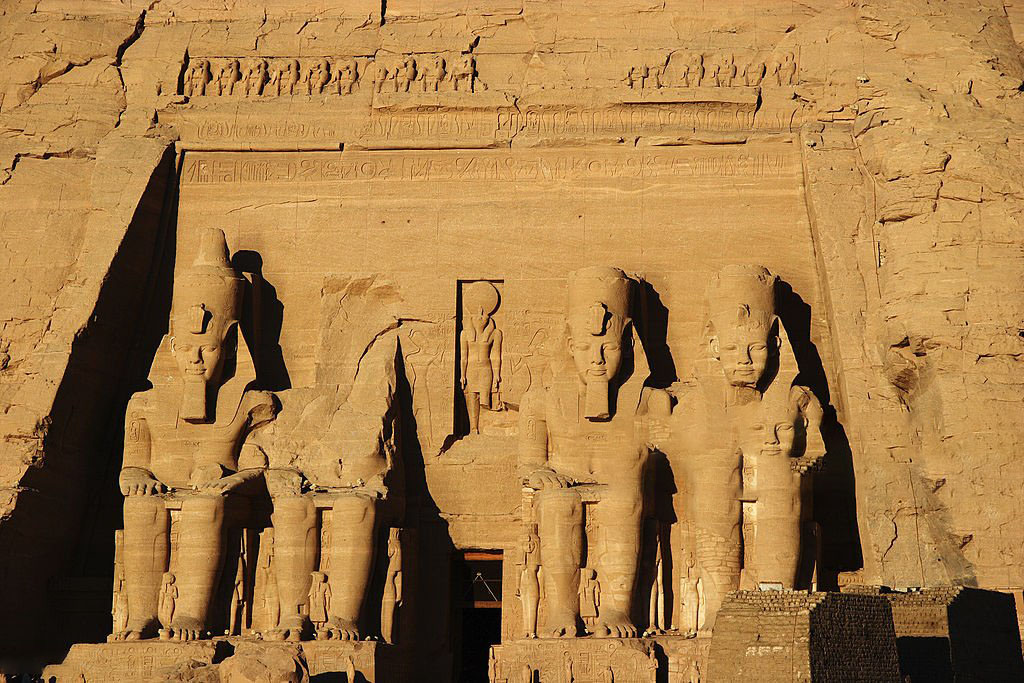
The Story of Pharaoh Ramses II
The magnificent Abu Simbel temples were commissioned by Ramses II, by whom one of ancient Egypt’s most powerful dynasties was led. These remarkable structures were carved directly into a mountainside, where acts of religious devotion were combined with impressive displays of royal authority.
Architectural Marvel of Abu Simbel
By the main temple’s facade, four colossal statues of Ramses II are featured, where the pharaoh is depicted seated on his throne, with each statue being measured at approximately 20 meters in height. Twice annually, the sun’s rays are perfectly aligned by which the inner sanctuary is illuminated—a phenomenon by which ancient Egypt’s sophisticated astronomical knowledge is demonstrated.
Relocation of the Temples
In the 1960s, the temples of Abu Simbel were threatened by submersion due to the construction of the Aswan High Dam. Through an unprecedented engineering achievement, the entire complex was dismantled and reconstructed piece by piece at a higher elevation—by which it was proved that modern technology could be effectively utilized to preserve the treasures of Egypt.
7. The Great Sphinx of Giza – Guardian of the Plateau

History of the Sphinx
The Great Sphinx of Giza, also known simply as the Sphinx of Giza, is one of the most fascinating treasures of Egypt. Scholars often ask when was the Great Sphinx of Giza built or even when was the Great Sphinx of Giza made, and most agree it was constructed during the reign of Pharaoh Khafre around 2500 BCE. For travelers wondering who built the Sphinx and why was the Great Sphinx built, it is believed to represent Pharaoh Khafre himself, serving both as a guardian of the pyramids and as a symbol of royal power and divine protection.
Architectural Beauty
For those asking what is the Great Sphinx of Giza or what is the size of the Great Sphinx of Giza, the answer lies in its massive scale: about 73 meters long and 20 meters high, making it the largest monolithic statue in the world. The Great Sphinx of Giza Egypt faces east, greeting the rising sun each day, a detail that emphasizes its spiritual importance. Despite erosion and missing features, the artistry of the Sphinx Egypt still inspires awe. Many visitors seek out a picture of Sphinx or capture their own Great Sphinx of Giza photos, especially with the pyramids in the background.
Significance in Ancient Egypt
Where is the Great Sphinx of Giza located? It sits on the Giza Plateau, guarding the pyramids as it has for nearly 4,500 years. As the eternal sentinel of ancient Egypt, the Great Sphinx of Giza built in the Old Kingdom remains a timeless icon of mystery, power, and spirituality. For historians, travelers, and photographers alike, the Great Sphinx of Giza continues to stand as one of the most enduring and unforgettable monuments in Sphinx Egypt.
8. Edfu Temple – A Testament to Horus, the Falcon God
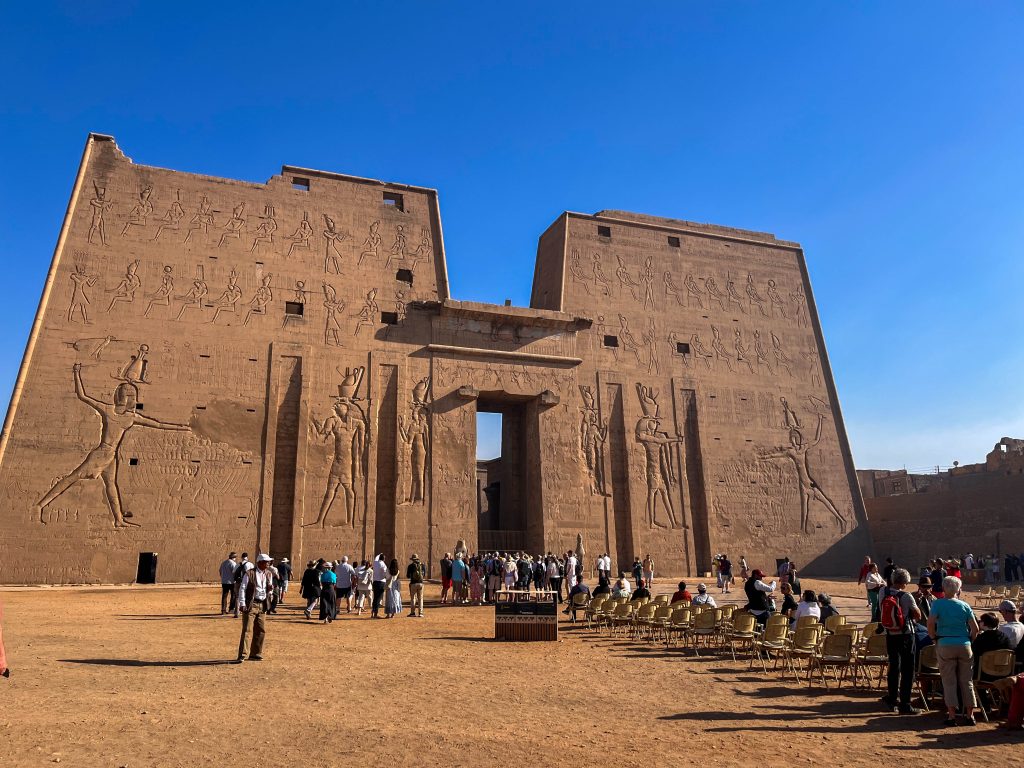
History of the Temple of Edfu
The Edfu Temple, also known as the Temple of Edfu or the Temple of Horus at Edfu, is one of the most extraordinary treasures of Egypt. For travelers asking where is Edfu Temple, it lies between Luxor and Aswan, on the west bank of the Nile, in the city of Edfu in Egypt. Constructed between 237 and 57 BCE, it is the best-preserved Ptolemaic temple. When exploring who built the Temple of Edfu, history credits the Ptolemaic kings, who raised this monument to honor Horus, the falcon-headed god of protection. The walls preserve inscriptions recounting Horus’s mythical battles with Seth, making the site a vital source of religious history.
Architectural Grandeur
Visitors often wonder where is the Temple of Edfu located or more broadly where is the Temple of Horus Edfu Egypt—the answer is in Upper Egypt, where it dominates the heart of the modern town of Edfu. Passing through its towering pylon entrance, travelers find themselves inside vast courtyards, colonnaded halls, and the sacred sanctuary where the cult statue of Temple of Horus once stood. The Temple of Horus at Edfu also contains reliefs depicting festivals that once connected it symbolically to other sacred sites such as the Temple of Osiris Egypt at Abydos.
Why It’s a Must-Visit
The Edfu Temple Egypt remains an awe-inspiring highlight of any Nile journey. As one of the best-preserved temples in the country, it gives travelers a vivid idea of what worship in the Ptolemaic era looked like. From monumental gateways to the sacred shrine, the site captures the scale and devotion of ancient Egyptian religion. While modern Edfu is also known for discoveries such as the less-visited Edfu South Pyramid, it is the Temple of Horus Edfu Egypt that draws thousands of visitors each year. For anyone seeking the essence of ancient devotion, the Temple of Edfu stands among the most unforgettable treasures of Egypt.
9. The Rosetta Stone – Unlocking the Language of the Pharaohs
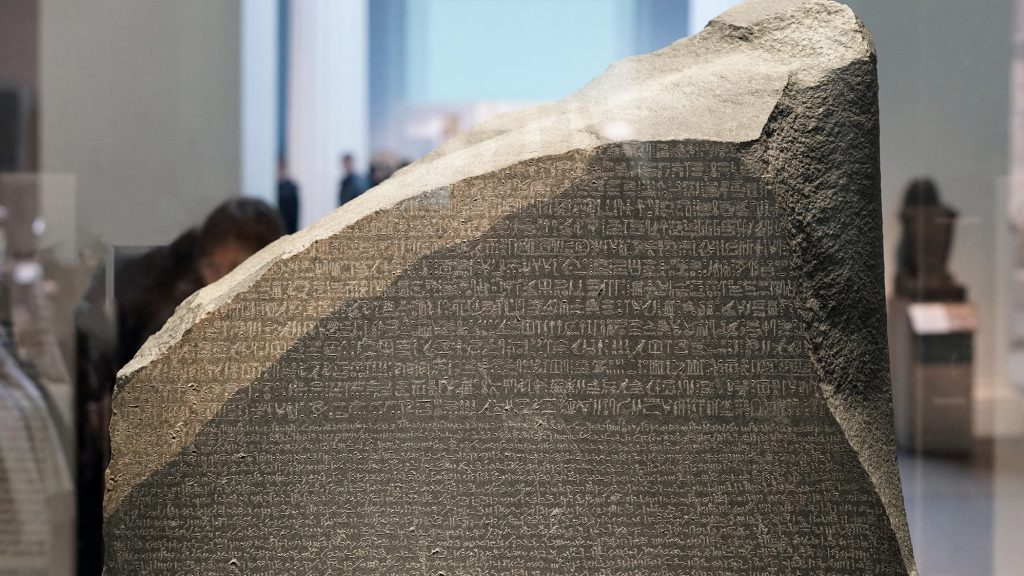
History of the Rosetta Stone- A Unique Egyptian Treasure
Among the greatest treasures of Egypt, the Rosetta Stone stands out as the key to unlocking ancient hieroglyphs. For those asking what is the Rosetta Stone or what is the Rosetta Stone Spanish, it is not only a historical artifact but also a modern term associated with language-learning software. The original artifact, discovered in 1799 near the town of Rosetta (Rashid) in Egypt, dates back to 196 BCE. For anyone wondering when was the Rosetta Stone created, it was inscribed during the reign of King Ptolemy V.
What the Stone Reveals
Travelers often ask what does the Rosetta Stone say. The answer is that it records a decree honoring Ptolemy V, carved in three scripts: hieroglyphic, Demotic, and Greek. These languages on the Rosetta Stone allowed scholars, most notably Jean-François Champollion, to finally decipher ancient Egyptian writing. For language enthusiasts, this connection sometimes leads to questions like is Rosetta Stone worth it or exploring Rosetta Stone languages and even checking a Rosetta Stone login to learn modern tongues—though all of these draw inspiration from the same idea: unlocking communication.
Where the Rosetta Stone Is Today
Many travelers ask where is the Rosetta Stone or search “Rosetta Stone where.” Today, the original artifact is displayed at the British Museum in London, ( you can get the chance to See the Rosetta Stone and other treasures of Egypt in the Egyptian sculpture gallery). though countless replicas and digital versions can be seen worldwide. As one of the most famous treasures of Egypt, the Rosetta Stone continues to bridge the gap between the ancient and modern worlds. Whether encountered as the priceless artifact itself or as part of a global language-learning tool, the Rosetta Stone remains an enduring symbol of knowledge, translation, and human curiosity.
10. Ramses III – The Last Great Pharaoh of the New Kingdom
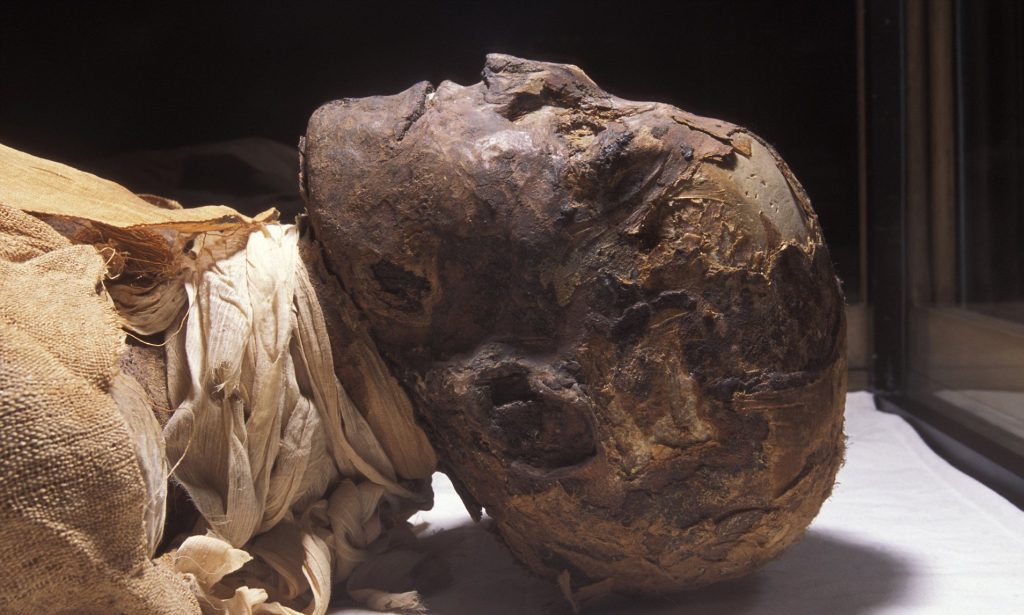
Who Was King Ramses III?
Ramses III, also known as Usermaatre Meryamun Ramesses III , was the second pharaoh of Egypt’s 20th Dynasty and is often regarded as the last great ruler of the New Kingdom. For history enthusiasts asking, “Who was King Ramses?”, he was a warrior king who defended Egypt from invasions by the Sea Peoples around the 12th century BCE. His reign preserved Egypt’s sovereignty during a time of great turmoil, leaving a legacy of resilience and power.
Achievements and Legacy
As Pharaoh Ramses III (sometimes written as Ramesses III), he continued the grand building projects of his predecessors, leaving behind temples, inscriptions, and monuments that celebrate his victories and devotion to the gods. One of the most notable sites is his mortuary temple at Medinet Habu, where detailed reliefs depict his triumphs. Through these records, modern historians recognize Pharaoh Ramesses III as both a defender and a builder, ensuring his place among Egypt’s greatest leaders.
The Mummy of Ramses III
The story of Ramses III’s mummy adds an intriguing chapter to his life. When his remains were discovered, forensic studies revealed evidence of a violent death, leading scholars to believe he may have been the victim of a palace conspiracy. Modern analysis has even shed light on the use of Egyptian mummification fats in his embalming process, revealing ancient techniques of preservation. Despite this mystery, the preserved body of King Ramses III allows us to glimpse the face of a man who once ruled one of the world’s most powerful civilizations.
Why He Matters Today
Remembered interchangeably as Ramses III, Ramesses III, or simply Ramesses, he stands as a figure of resilience in Egyptian history. Through his battles, his monumental works, and even the mystery surrounding his death, the legacy of Pharaoh Ramses III continues to fascinate travelers, scholars, and anyone captivated by the treasures of ancient Egypt.
Conclusion: Your Gateway to Timeless Treasures of Egypt
The famous landmarks in Egypt showcase the nation’s rich history, timeless culture, and extraordinary treasures that continue to inspire the world.
By these unique treasures of Egypt, which cannot be replicated or found elsewhere, Egypt secures its position as an unparalleled destination. Whether the majestic Abu Simbel temples are admired, Mount Sinai’s summit at dawn is reached, or the Grand Egyptian Museum’s vast collections are explored, by visitors a journey through time is experienced.
If Egyptian adventures have been contemplated, by you the perfect moment for action has been reached. Through each site that is visited, direct engagement with history is achieved.
